
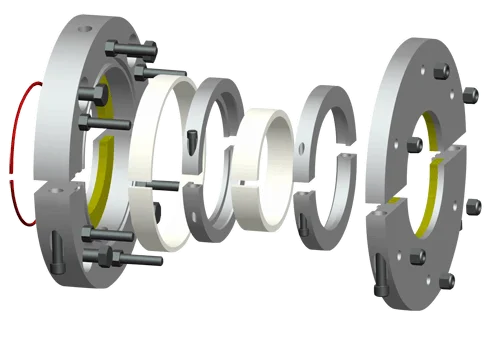
Meco to amerykański producent szerokiej gamy uszczelnień mechanicznych przeznaczonych do mediów sypkich. Firma istnieje od 1985 roku, kiedy to zwrócono się do niej z prośbą opracowania uszczelnienia do powstającego standardu konstrukcyjnego mieszadeł CEMA. Zadanie wymagało opracowania nowatorskich rozwiązań, gdyż założenia co do jego trwałości, jakości wykonania i łatwości montażu były bardzo wygórowane. Meco sprostało wyzwaniu, opracowując całą linię różnorodnych uszczelnień przeznaczonych do mediów sypkich. Na czerwono wyróżniliśmy typowe aplikacje dla każdej z serii:
Seria HB i HC
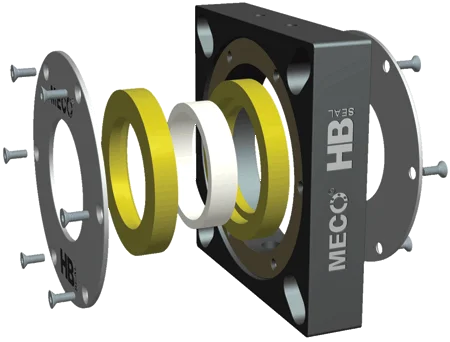
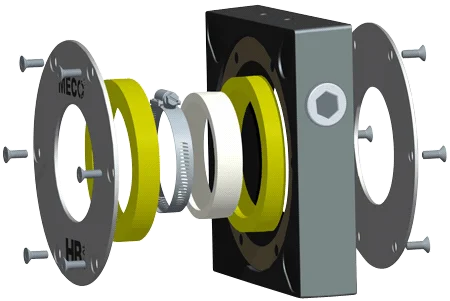
Czym jest seria MECO HB?
Uszczelnienia serii HB to najlepsze technologicznie rozwiązania do uszczelniania podajników śrubowych. Seria HB to uszczelnienie kontaktowe wału, używające elastomerowego napędu obracającego syntetyczne pierścienie klasy łożyskowej dociskające pierścienie uszczelniające ze stali nierdzewnej. Różnorodne wersje rozmiarowe są zgodne z calowym standardem CEMA oraz ich metrycznymi odpowiednikami. Uszczelnienia HB oferują nadzwyczajną sprawność, wytrzymałość oraz jakość wykonania, będącą znakiem rozpoznawczym uszczelnień MECO. Wsparcie doświadczonych inżynierów jest składową każdego sprzedanego uszczelnienia MECO.
Kiedy seria HB jest najlepszym wyborem?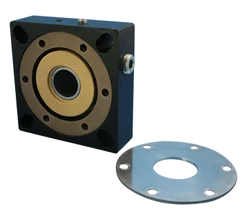

Uszczelnienia serii HB idealnie pracują na podajnikach śrubowych, niewielkich mieszadłach, przenośnikach kubełkowych i niewielkich urządzeniach obrotowych używanych w produkcji masowej. Uszczelnienie to może pracować w poziomie, pionie oraz na wałach pochylonych pod dowolnym kątem. Uszczelnienie nie jest dzielone, więc do jego wymiany wymagany jest demontaż uszczelnianego urządzenia.
Jaka jest zasada działania uszczelnień serii HB?
Uszczelnienia serii HB mogą pracować w miejsce standardowej komorze dławnicowej. Jest wykonane z masywnego kawałka metalu lub dopuszczonego do przemysłu spożywczego nylonu, który nie może zostać uszkodzony poprzez nadmierne dokręcenie. Dwa pierścienie uszczelniające ze stali nierdzewnej są przymocowane do obudowy uszczelnienia. wewnątrz uszczelnienia znajdują się części obrotowe, napędowe oraz elastomery. Elastomery i elementy obrotowe blokują się wzajemnie tworząc wodo i powietrzno-odporne uszczelnienie. Niskotarciowe obracające się elementy uszczelnienia ustawiają się pod odpowiednim kątem do wału i są w bezpośrednim kontakcie z stacjonarnymi pierścieniami uszczelnienia.
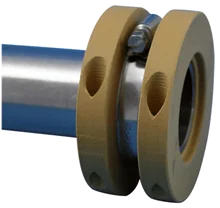 Komora uszczelnienia serii HB jest wypełniona powietrzem lub gazem o niskim ciśnieniu, co działa jak ciecz zaporowa zapewniając pneumatyczny docisk pierścieni uszczelnienia. Dzięki temu w prosty i efektywny sposób można sprawdzić poprawność instalacji oraz stan uszczelnienia. Uszczelnienia serii HB gwarantują idealną równoległość i płaskość pierścieni uszczelniających aby zminimalizować zużycie gazu zaporowego. Alternatywnie uszczelnienia serii HB mogą zostać przekonfigurowane aby pracować bez gazu zaporowego, używając opaski zaciskowej w celu dociskania pierścieni. Taki model oznaczony jest jako seria HC.
Komora uszczelnienia serii HB jest wypełniona powietrzem lub gazem o niskim ciśnieniu, co działa jak ciecz zaporowa zapewniając pneumatyczny docisk pierścieni uszczelnienia. Dzięki temu w prosty i efektywny sposób można sprawdzić poprawność instalacji oraz stan uszczelnienia. Uszczelnienia serii HB gwarantują idealną równoległość i płaskość pierścieni uszczelniających aby zminimalizować zużycie gazu zaporowego. Alternatywnie uszczelnienia serii HB mogą zostać przekonfigurowane aby pracować bez gazu zaporowego, używając opaski zaciskowej w celu dociskania pierścieni. Taki model oznaczony jest jako seria HC.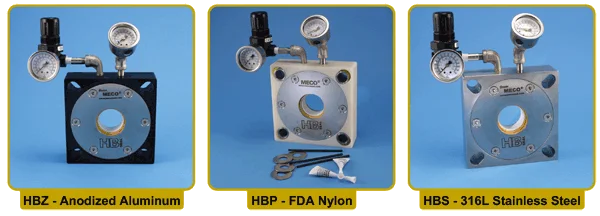
Serie dla aplikacji Atex
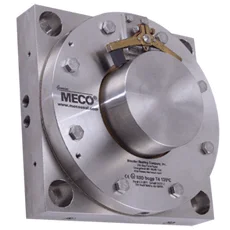
O co chodzi z Atexem?
ATEX to certyfikat potwierdzających brak iskrzenia, zgodny z EN 94/9/EC, który producent musi dołączyć do produktów sprzedawanych w Unii Europejskiej. Certyfikacja przenosi prawnie ryzyko używania certyfikowanego urządzenia i jego podzespołów. ATEX został ustanowiony w 2003 roku i każde urządzenie wyprodukowane po tej dacie musi być z nim zgodne. Maszyny i urządzenia wyprodukowane przed 2004 rokiem, w przypadku ich modernizacji czy rozbudowy, muszą być wyposażane w podzespoły zgodne z certyfikatem ATEX.
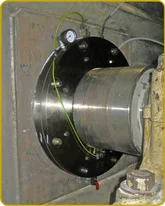 Czy MECO oferuje uszczelnienia zgodne z ATEX?
Czy MECO oferuje uszczelnienia zgodne z ATEX?Tak - Meco mogą być zaprojektowane do pracy w atmosferze wybuchowej, gdzie należy przestrzegać normy EN 94/9/EC.
Dla starszych urządzeń, wyprodukowanych przed wprowadzeniem normy 94/9/EC, MECO oferuje specjalne wersje uszczelnień oznaczone EX. Producenci nowych maszyn mogą zakupić od MECO uszczelnienia oznaczone jako EX, lub standardowe uszczelnienie MECO i objąć je własnym certyfikatem ATEX jako część maszyny.
Czym różnią się uszczelnienia MECO z certyfikatem ATEX od pozostałych?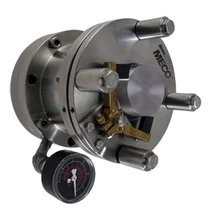

Używanie szczeliw sznurowych lub innych uszczelnień powodujących silne tarcie może być niekontrolowanym źródłem ciepła i większości wypadków normy unijne wymagają zastosowania alternatywnych rozwiązań, zgodnych z ATEX. Niektóre uszczelnienia mechaniczne spełniają normy ATEX, ale wymagają jednocześnie stosowania wody zaporowej do ich chłodzenia, co często jest nieakceptowalne przy mediach sypkich. Technologia miękkich pierścieni uszczelniających MECO, dzięki właściwościom smarnym użytych materiałów generuje dużo mniej ciepła, więc uszczelnienie może się obyć bez wody zaporowej. Niektóre modele uszczelnień MECO mają certyfikację ATEX zgodną ze wszystkimi jego wymaganiami - przeniesienie ryzyka, testy cieplne i dokumentacja, zestaw testów pomiarowych analizujących źródła zapłonu, kontrola temperatury pierścieni uszczelniających i izolacja od atmosfery. Przed opuszczeniem fabryki, uszczelnienia MECO ze znakiem EX jest testowane w warunkach zbliżonych do warunków jego pracy - badana jest temperatura pierścieni uszczelniających aby upewnić się, że będzie się ona zawierała w bezpiecznym przedziale. Indywidualny certyfikat testu jest dołączany do każdego uszczelnienia.
Seria AH

Czym jest seria uszczelnień Meco AH?
Meco AH Typ-2 jest najlepszym wyborem, gdy mamy bardzo mało miejsca na uszczelnienie, które musi być dzielone ze względu na dużą średnicę wału. Uszczelnienie to podwójne uszczelnienie mechaniczne z napędem elastomerowym obracającym pierścienie z tworzywa klasy łożyskowej dociskane do pierścieni ze stali nierdzewnej. AH Typ-2 używa cieczy buforowej aby zapewnić docisk par uszczelniających i odizolować proces od atmosfery. AH Typ-2 jest dostaczany do nowych jak i starszych maszyn.
Kiedy seria AH jest najlepszym wyborem?
Seria uszczelnień AH Typ02 jest odpowiedzią na pytanie: Jak możemy zmieścić dzielone uszczelnienie w przestrzeni przewidzianej dla uszczelnienia niedzielonego? Ten Model uszczelnienia jest zaprojektowany do pracy w układach poziomych, pionowych oraz ukośnych. Uszczelnienie to stosuje się, gdy wymagane jest rozdzielenie prosesu od atmosfery medium buforowym. Uszczelnienie to jest stosowane w mieszadłach, podajnikach czerpakowych, niektórych ekstruderach do tworzyw, oraz na obu końcach podajników śrubowych. Zachowując podstawowe założenia konstrukcyjne możliwe jest wykonanie z dowolnych materiałów. Uszczelnienie może być zaprojektowane aby pasowało do przestrzeni pomiędzy przekłądnią a końcem podajnika śrubowego jak pokazano poniżej.
Jaka jest zasada działania uszczelnień AH?
Uszczelnienie AH Typ-2 składa się z zewnętrznej i wewnętrznej obudowy bądącej jednocześnie stacjonarnym elementem uszczelnienia mechanicznego. Pomiędzy stacjonarnmi częściami uszczelnienia obracają się dwa elementy obrotowe rozdzielone elastomerem. Poprzez skręcenie części stacjonarnych dociska się elementy obrotowe i przyciska elastomer do wału tworząc tym samym wodoszczelne uszczelnienie. Ponieważ elastomer rozpręża się pomiędzy wałem a elementem obrotowym, powierzchnie pomiędzy pierścieniami obrotowymi a stacjonarnymi zachowują się jak łożysko ślizgowe. Pierścienie obrotowe, wykonane są z materiału o bardzo niskim współczynniku tarcia są w kontacie z wałem pod właściwym kątem i idealnie dociskają do pierścieni stacjonarnych tworząc płaszczyznę uszczelniającą. Docisk pierścieni jest zwykle realizowany poprzez sprężone powietrze. Dwie części obudowy są zwykle rozdzielone zestawem ciękich (0.4mm) podkładek aby umożliwić pewną korektę ich ustawienia.
Seria EA - Typ 1
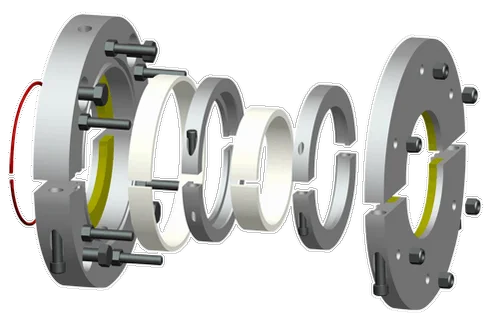
Czym jest seria Meco EA Typ-1?
Meco Typ 1 jest uszczelnieniem o bardzo szerokim zastosowaniu w przemyśle papierniczym -
particularly stock chest agitators, repulpers and chip screws – and in other processes involving wet, abrasive slurries like drywall mud.
Uszczelnienie EA Typ-1 kompensuje pewien poziom bicia wału sprawdza się w aplikacjach, gdzie szczeliwo sznurowe lub tradycyjne uszczelnienia mechaniczne odmawiają poprawnej pracy. Uszczelnienie jest w pełni dzielone, w większości wypadków jego instalacja lub serwi odbywa się bez jakichkolwiek demontaży lub modyfikacji obecnej dławnicy, łożysk czy napędu.
Kiedy uszczelnienie EA Typ-1 jest najlepszym wyborem?
Uszczelnienie EA Typ-1 bardzo dobrze sprawdzają się na poziomych - stock chest agitators – on cantilevered shafts and on older through shafts and mid-feather agitator designs.
Ta rodzina uszczelnień była pierwotnie projektowana dla podajników śrubowych więc ciągle idealnie spisują się na stock washer repulper screws and on TMP chip conveyors. Bottom-entry and side-entry pulpers are best sealed with MECO’s EP Type-1 seal. Do dolnego i bocznego wsadu najlepiej wybrać uszczelnienie Meco EP Typ-1.
Jak działa uszczelnienie Meco EA Typ-1?
Uszczelnienie EA Typ-1 umożliwia przeprowadzenie kalibracji jego położenia z zewnątrz, bez potrzeby jego demontażu. Dy pierścienie uszczelniające się zużywają, uszczelnienie można dociągnąć aby skompensować to zużycie zanim nastąpi nadmierny wyciek. Monitoring the adjustments permits planned maintenance, without catastrophic seal failures. The EA Type-1 is an unbalanced, double mechanical seal. The design places two rotating seal faces against a central driving elastomer. The elastomer turns with the shaft, and the two rotors turn with the elastomer. The elastomer provides a static seal against the shaft, drives the rotors, and serves as the load spring for the seal. Wide radius faces permit the seal to accommodate total shaft runout from 1/4" to 3/8" or more. Split stationary faces are replaceable, making rebuilds simple and inexpensive. A water flush trickles into the top of the seal cavity and out a vent at the bottom, (or side-to-side in vertical applications), providing cooling and expelling any stray fiber which might make its way past the primary seal face. Unlike mechanical packing, the EA seal does not require flush water across the seal interface. Flush water is confined to the interior of the seal, between the two rotating faces. Stock dilution cannot occur because the flush runs at zero pressure, preventing water leakage past the seal faces.
Seria EA - Type 2
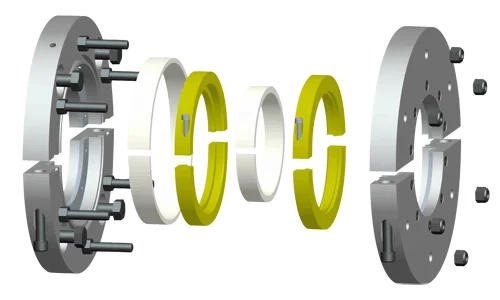
What Is MECO’s EA Type-2 Seal?
The MECO EA Type-2 model is the best choice in many sealing applications for low to moderate shaft speeds on small to very large shaft diameters. The EA Type-2 uses full-contact, soft-face mechanical shaft sealing technology, sized for OEM and custom in-house process equipment. The EA Type-2 model provides the superior performance, durability and quality of workmanship that are hallmarks of MECO’s many other highly-regarded seals. MECO’s first rate customer service is provided for each EA Type-2 seal sold.
When Are EA Type-2 Seals The Best Option?
The MECO EA Type-2 seal model is ideal for large solvent extractors, pressurized conveyors, holding tanks or similar rotating equipment. Fitment for some blenders, dryers & sigma mixers is also possible. Common industries that use the seal are plastics, oilseed processors, chemicals, carbon anodes, metals, pharmaceuticals and food processors. The EA Type-2 seal model is typically used on horizontal, inclined or vertical shafts and configured for a fully-split installation. They are frequently used on rotating shafts where an inert gas barrier in the seal chamber is beneficial.
The seal is appropriate for vacuum service and steady-state applications with infrequent thermal expansion or pressure changes. The seal is adjustable without having to empty the process material. For applications with frequent thermal cycles, pressure cycles and/or aggressive chemicals, the MECO Model EP Type 3 seal is a better match.
How Does The EA Type-2 Seal Model Work?
The EA Type-2 seal model replaces standard stuffing boxes & packing glands. The seal incorporates separate inboard and outboard stator housings acting as the stationary seal faces. Between the stators is a rotating seal face assembly, consisting of two replaceable rotors and a drive elastomer. The stators are drawn together to compress the two seal rotors against a central driving elastomer. The drive elastomer and rotors interlock to the shaft, forming an air and watertight seal. The low-friction rotating seal faces are at right angles to the shaft and in full contact with the stationary seal faces.
An adjusting gasket permits the distance between the two stator housings to be varied, while containing a barrier fluid within the seal. The EA Type-2 seal cavity is charged with low-pressure air or an inert gas, which acts as a barrier fluid to provide pneumatic seal face loading. This is a simple and effective way to check installation integrity and monitor seal performance. The EA Type-2 seals are manufactured to exacting standards, which ensure parallelism and flatness to maximize product containment and minimize barrier gas consumption.
Seria EP - Type 1
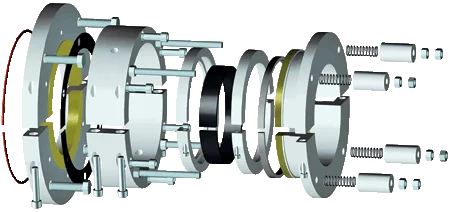
What is MECO’s EP Type-1 Seal?
The MECO EP Type-1 seal model is the best choice in wet sealing technology on moderate to very large shaft diameters entering the vessel from any direction. The fully-split configuration uses an elastomer drive to rotate two hardened stainless steel seal faces against two fixed polymeric bearing grade stationary seal faces. The EP Type-1 is designed around its’ own fully split stuffing box type housing that utilizes external springs to close the seal faces. The entire package results in a rugged, runout tolerant design.
When are EP Type-1 Seals The Best Option?
The MECO EP Type-1 seal model is a great solution in wet abrasive slurry sealing applications such as pulpers, agitators, holding vessels, cylindrical blenders, ribbon and paddle blenders, conveyors and similar rotating equipment. The seal is used in process industries such as: pulp & paper, homebuilding products such as drywall joint compound, biomass production, ethanol production and others handling water slurries. The EP Type-1 seal model is fully-split, easing the installation on a bottom-entering shaft. They are frequently used on bottom-entry pulpers containing clean wood fiber, recycled office paper or other corrugated cardboard (OCC). They withstand the shock-loading and high shaft runout associated with pulpers.
How does the EP Type-1 Seal model work?
The MECO EP Type-1 seal model is a precision machined, fully-split seal akin to a stuffing box and gland follower. The elastomer drive is comprised of two rotating seal faces and a drive elastomer. The drive elastomer and two rotating seal faces interlock with the shaft, forming a watertight seal at the shaft. The result places the rotating seal faces at right angles to the shaft and in full contact with the low-friction stationary seal faces. The rotating parts are fitted around the shaft prior to installing the seal housing.
The nose or pilot of the gland follower provides the carrier for attaching the outboard (secondary) stationary seal face. A plate attached to the bottom of the seal housing (a.k.a. stuffing box) provides the inboard (primary) stationary seal face. These precision-machined stationary seal faces (stators) are inherently malleable to mate against hardened, lapped and polished rotating seal face surfaces. The seal cavity is flushed with water to remove any debris and quench or cool the seal faces.
The nose or pilot of the gland follower provides the carrier for attaching the outboard (secondary) stationary seal face. A plate attached to the bottom of the seal housing (a.k.a. stuffing box) provides the inboard (primary) stationary seal face. These precision-machined stationary seal faces (stators) are inherently malleable to mate against hardened, lapped and polished rotating seal face surfaces. The seal cavity is flushed with water to remove any debris and quench or cool the seal faces.
Seria EP - Type 2
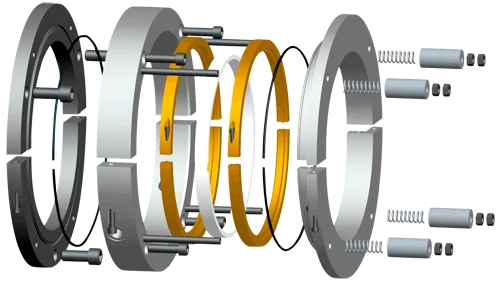
What is MECO’s EP Type-2 Seal?
The MECO EP Type-2 model is the best choice for many sealing applications with low to medium-high shaft speeds, on small to large shaft diameters. The configuration is a double mechanical seal using an elastomer drive to rotate bearing-grade, synthetic seal faces against fixed, hardened stainless steel seal faces. The EP Type-2 uses full-contact, soft-face mechanical shaft sealing technology, sized for OEM and existing in-house process equipment. The EP Type-2 model provides the superior performance, durability and quality of workmanship that are hallmarks of MECO’s many other highly-regarded seals. MECO’s first-rate customer service is provided for each EP Type-2 seal sold.
When are EP Type-2 Seals the Best Option?
The MECO EP Type-2 seal is ideal for single- or twin-shafted extruder-compounders, plow blenders, paddle blenders, conveyors and similar rotating equipment used in the plastics, chemical, metals, pharmaceutical, food and other process industries. The EP Type-2 seal model is typically used on horizontal or inclined shafts configured for a fully-split installation. They are frequently used on polymer extruders containing particulates and vapors. They are well-suited for hard-to-access equipment and machinery with set speeds and feed rates. The seal is appropriate for vacuum service, low pressures and steady-state applications that experience infrequent thermal expansion or pressure changes. In contrast, the MECO Model EP Type-3 seal is better matched for the challenges of applications with frequent thermal cycles, pressure cycles and/or aggressive chemicals.
How does the EP Type-2 Seal model work?
The MECO EP Type-2 seal model features a precision-machined, split seal housing similar to a stuffing box and gland follower. The elastomer drive has two rotating seal faces and a drive elastomer. The elastomer and rotors interlock, forming an airtight and watertight seal. The low-friction rotating seal faces are at right angles to the shaft and in full contact with the stationary seal faces. These rotating parts are fitted around the shaft before the seal housing is installed.
The nose or pilot of the gland follower provides the outboard (secondary) stationary seal face. A plate attached to the bottom of the stuffing box provides the inboard (primary) stationary seal face. These are precision machined stationary seal faces (stators) with hardened, lapped and polished seal surfaces. The seal cavity is charged with low-pressure air or an inert gas, which acts as a barrier fluid to provide pneumatic seal face loading.
Seria EP - Type 3
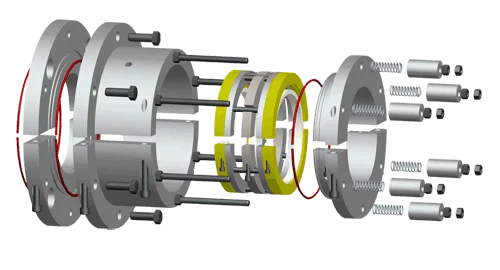
What is MECO’s EP Type 3 Seal?
The MECO EP Type 3 model is the best choice in split sealing technology for horizontal dryers and reactors in vacuum service. The configuration is a double mechanical seal, using a mechanical drive to rotate bearing-grade, synthetic seal faces against fixed, hardened stainless steel seal faces. The EP Type 3 uses full-contact, soft face mechanical shaft sealing technology, sized for OEM and custom in-house process equipment.
When are EP Type 3 Seals The Best Option?
The MECO EP Type 3 split seal model is ideal for dryers, sigma mixers, plow blenders, paddle blenders, reactor vessels, extruder-compounders and similar rotating equipment used in the chemical, plastics, metals, pharmaceutical and other process industries. The EP Type 3 seal model is typically used on horizontal, inclined or top-entering shafts. The seal addresses the challenges of higher temperatures, large thermal motion, changing pressures and shaft runout. They are frequently used on agitator shafts in reactors where the process medium goes through several phase changes, containing liquids, vapors and/or solids. They are well-suited for extensive thermal growth or shrinkage of the shaft and/or vessel. They are ideal for vacuum service and moderate pressure applications. They may be used for processes where aggressive solvents, hazardous materials and other chemicals are present. They handle the higher shaft speeds and shaft runout associated with large extruder-compounders.
How does the EP Type 3 Seal model work?
The MECO EP Type 3 seal model utilizes a precision machined split seal housing similar to a stuffing box and gland follower. The MECO-DR or mechanical drive consists of all the rotating seal components. These rotating parts are fitted around the shaft prior to installing the seal housing.
The MECO-DR is comprised of rotating seal faces, braided packing, pusher rings, drive pins and a drive collar. The MECO-DR mechanical drive attaches only one component, the drive collar, to the shaft. Pusher rings are permitted to float on either side of the drive collar. Large diameter, fixed length drive pins link the two pusher rings a fixed distance from each other with the drive collar positioned between them. The drive collar is set at a predetermined distance from the pusher rings. On the other side of the pusher rings are two sets of braided packing rings followed by the rotating seal faces (rotors). Together, the pusher ring & rotor contain each set of braided packing, forming a static seal to the shaft. The rotor orients the dynamic sealing surface perpendicular to the shaft, permitting radial shaft runout, as compared to a stuffing box and packing which compress the shaft radially.
The MECO-DR allows the shaft to move axially, sliding on the packing, limited only by the length of the drive pin. The drive collar locked to the shaft engages the drive pins, transferring the torque from the shaft to the seal faces and allowing the seal to compensate for thermal growth.
The nose or pilot of the gland follower provides the outboard (secondary) stationary seal face. A plate attached to the bottom of the stuffing box provides the inboard (primary) stationary seal face. These are precision machined stationary seal faces (stators) with hardened, lapped and polished seal face surfaces.
Seria OFS - Type 1
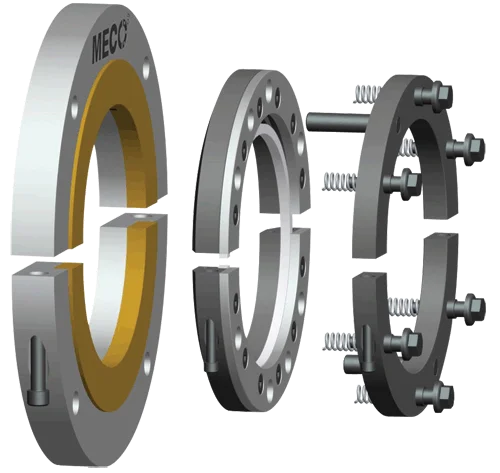
What is MECO’s OFS Type-1 Seal?
The MECO OFS Type-1 seal is frequently the best, fully-split seal for vacuum, low pressure, and abrasive applications. The design tolerates both runout and thermal growth at moderate speeds. The OFS Type-1 places a single, hardened, stainless steel rotary seal face, spring-loaded against a single, bearing-grade, polymeric stationary seal face. The seal does not require a barrier fluid. A wide selection of materials are available, allowing service in diverse processes. The fully-split seal is custom-designed for existing process equipment or is tailored to OEM or end-users wishes.
When are OFS Type-1 Seals the Best Option?
The OFS Type-1 split seal is ideal for top-entry agitators, crystallizers, dryers, pan mixers, blenders, hoppers and similar rotating equipment used in the petrochemical, plastics, metals, minerals and other process industries. The OFS Type-1 seal is used with top-entering and horizontal shafts. The seal has been used with crystallizers operating at cryogenic temperatures, and in an environment with saturated steam under full vacuum and relatively hot conditions. The seal is often used both to keep process materials inside the vessel and also to keep atmospheric oxygen from entering the vessel. The OFS Type-1 is used in the production of plastic resins and additives, paraxylene, solvent-based ink, VOC vapors and fumes, crystal sugar, industrial chemicals and industrial fermentation processes. Process improvements encompass product and atmosphere containment, product purity, batch time reduction and consistency between batches, extended mean-time-to-repair (MTR), and only two to four hours of installation time once the equipment is prepared. The fully-split assemblies meet chemical compatibility and materials of construction challenges.
How does the OFS Type-1 Seal Work?
The OFS Type-1 seal replaces stuffing boxes, lip seal housings, hard-face mechanical seals, elastomer-driven seals and unsplit seals. The split seal housing is fitted to your equipment, complete with a split, bearing-grade, synthetic stationary seal face. Typically, the rotary seal face is made from hardened, stainless steel, positioned at a right angle to the shaft and is maintained in contact with the stationary seal face. Sealing along the shaft is accomplished with a static ring of braided packing or a square elastomer, contained within the inner diameter of the rotating seal face. The rotary seal face is turned by drive pins, fixed to a drive collar which is locked to the shaft. External springs & actuators are attached to the drive collar to load the rotary seal face. The seal designer predetermines the spring calibration, based on application parameters.
Seria OFS - Type 2
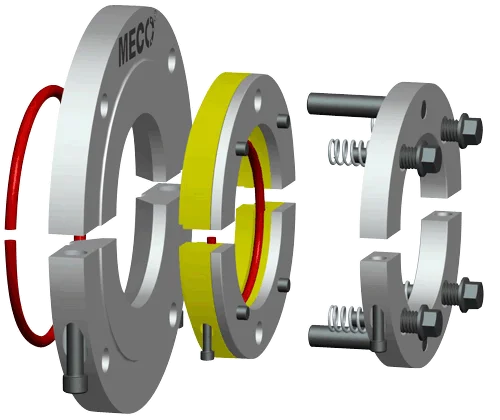
What Is MECO’s OFS Type-2 Seal?
The patented MECO OFS Type-2 model is the best choice in many sealing applications for low to moderate speed equipment. The OFS Type-2 uses full-contact, soft-face mechanical shaft sealing technology, sized for OEM and custom in-house process equipment. The OFS Type-2 model provides the superior performance, durability and quality of workmanship that are hallmarks of MECO’s many other highly-regarded seals. MECO’s first rate customer service is provided for each OFS Type-2 seal sold.
When Are OFS Type-2 Seals The Best Option?
The OFS Type-2 seal model is ideal for blenders, mixers, cookers, conveyors and similar rotating equipment used in the food, pharmaceutical, chemical, plastics, metals, and other bulk process industries. The OFS Type-2 seal model is used on horizontal, inclined, and top entering shafts for split and unsplit installations. They are frequently used in dry powder blending applications including sugar drink mixes, spices, flavorings, nutrients, plastic and metal powders, and chemicals. It is also used in wet mixing for products like soups, sauces & pet foods.
The single-face OFS Type 2 seal does not require a barrier gas, thus letting users steer clear of the costs and hassles associated with compressed air. The seal is extremely effective in vacuum service.
The OFS Type-2 seal model allows for easy, speedy cleaning. The seal may be washed in 10 minutes time while assembled on the blender or freely dissembled along the shaft for cleaning and inspection.
How Does The OFS Type-2 Seal Model Work?
The OFS Type-2 seal model replaces stuffing boxes, lip seal housings and other types of seals. It is made with a heavy, hardened stainless steel stationary seal face or stator that bolts directly to the machine. A low-friction rotating seal face is at a right angle to the shaft and in full contact with the stator. Sealing along the shaft is accomplished with an O-ring contained in the rotor that turns with the shaft and rotor. A drive collar, with large drive pins and self-contained springs, locks to the shaft at a predetermined distance from the rotor. Factory calibration is set by fully tightening the spring actuators, providing the seal face closing force.
Seria Meco-Pac
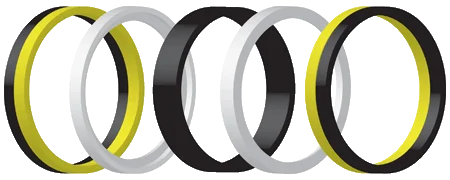
What Is The MECO-PAC Seal?
The MECO-PAC is an elastomer-driven, MECO seal designed to replace packing in stuffing boxes. It is used primarily in airlocks and rotary valves, where no installation clearance exists for an externally-mounted seal.
Like other MECO seals, the MECO-PAC seals on a plane perpendicular to the shaft, eliminating abrasive damage to the shaft caused by packing or lip seals. The MECO-PAC has proven effective in maintaining pressure differential across airlocks, without the frequent adjustments required by packings.
What Construction Is Available?
The MECO-PAC is available in several materials, for service in a wide variety of products, including food and pharmaceutical products, abrasives, hazardous and toxic materials. The MECO-PAC’s function is identical to that of the MECO EAS seal.
While the MECO-PAC can be built fully split, most installations do not offer sufficient radial clearance for split parts, and the seal is usually manufactured unsplit.
The MECO-PAC requires a minimum 5/16" packing section, a minimum bore depth of 1.313", and an air or gas purge of approximately ½ CFM at 3-5 psig.
MECO-PAC seals should only be used in applications where there is no possibility of installing an external seal. MECO-PAC seals can easily be damaged by overtightening. Since there is no external indication that the packing gland contains anything other than ordinary packing, it is essential that operating personnel be carefully trained, and made aware that the MECO-PAC is in place.
Seria Meco Marine Sea Gard
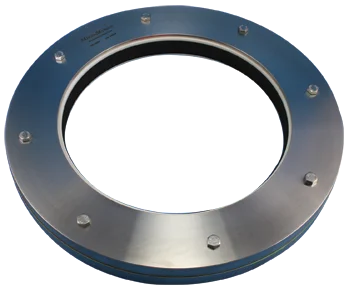
The SEA-GARD provides an effective rudder post seal in abrasive, coastal waters. Wear materials are softer than those used in traditional mechanical seals, and permit the use of wide-radius seal faces. These easily tolerate severe eccentric rotation and permit wear to occur without compromising the seal.
• Elastomeric Drive Design Tolerates Shock Loads & Radial Eccentricity
• Will Not Open Up Like Packing
• Long Service Life
• Fully-Split Designs Facilitate Easy Installation & Rebuild
The wide seal face radius permits the Sea-Gard to function despite severe bearing wear which causes other seals to leak. Seal face loading is accomplished by an elastomeric drive: there are no metallic springs to corrode and fail. The soft elastomer buffers shock loads and maintains seal integrity under the roughest operational conditions. The fully-split Sea-Gard is user-friendly and simple to install. Seal faces can be freely handled. There are no gauge blocks, calibration rods or special shaft finishes required for installation. An accurate shaft measurement prior to purchase ensures proper calibration on assembly. Sea-Gard seals are available in sizes to fit every rudder post diameter, and various materials permit compact designs for installation in areas with minimal axial clearance.

